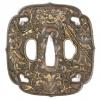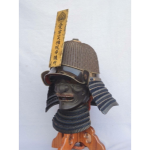-
Posts
33 -
Joined
-
Last visited
-
Days Won
3
Peter D last won the day on October 10 2024
Peter D had the most liked content!
About Peter D

- Birthday 09/16/1979
Contact Methods
-
Website URL
http://www.mandarinmansion.com
Profile Information
-
Gender
Male
-
Location:
Haarlem, the Netherlands
-
Interests
Antique arms of Asia. Chinese swords, Korean swords, Indian swords, and Japanese swords.
Profile Fields
-
Name
Peter Dekker
Peter D's Achievements
-

Hwando real korean or fake katana?
Peter D replied to vajo's topic in General Nihonto Related Discussion
Some Korean guards. Often with hitsu-ana that are more round on the inside. Sometimes larger, sometimes smaller than those found on Japanese examples. Nakago-ana often miss that narrowing towards the edge that you tend to see on Japanese work. -

Hwando real korean or fake katana?
Peter D replied to vajo's topic in General Nihonto Related Discussion
Korea is right in between the major powers Japan and China and it shows on their weapons and other regalia. They have a number of swords, some are much easier to differentiate from Japanese swords than others. Their straightswords generally follow the tradition of the Ming period in China, so they are easy to set apart from ken. Hwando Then there are the hwando, military sabers that are much more like Chinese yaodao (waist-worn sabers) than anything else. Korean swords are rare on the market, but this type turns up the most. The French army took a large number of them during a punitive expedition to Ganghwa Island in 1866, and they have been dispersed into collections worldwide since. Some have red writing on their sheats, dating to the late 18th century. All have iron mounts with silver overlay and octagonal guards. Occasionally, one sees guards separately sold as "nanban tsuba." The typical hwando, this one recently sold at Olympia Auction, lot 84. Wide blade more in the Chinese style. Typical Korean suspension system on scabbard, throatpiece missing. Grip wrap in the Japanese style but with hilt mounts following the late 18th-century Chinese transitional style between fangshi and yuanshi. (More about that here.) Joseon byeolun-geom Sabers worn by Joseon period military officials. This is the style most easily mistaken for Japanese swords. It is basically like a short tachi. Some of the best of them actually have Japanese-imported blades, so don't get distracted by the blade itself. Here is one I had, with a Japanese blade: The most obvious departures from Japanese design is the textile, if still present: a suspension system that more resembles the Chinese one, and a long tassel. Other tell-tale signs are the proportion of the hilt, and the fact it is often lacquered in the same style as the scabbard on this type of sword. Guards are modeled after Japanese guards but with odd placement and shape of the hitsu-ana. Often made of patinated silver, a Korean variety of shakudō but jade is also sometimes seen. The habaki also often look odd. Another aspect is that most of these were not made so they can be easily taken apart like the Japanese sword, so its often impossible to see the tang. Another one I had, again with a Japanese blade: Other types There is a whole range of other ceremonial Korean swords, but they are more easily discernible from Japanese swords because their blades are often roughly made and toy-like. They were more like a metal tsunagi sometimes. Here are two. -
Thanks, yes, if you can! The second character does look like 廣 "Hiro" from Mitsuhiro (光廣, the name ofed by the three Yagami mainline makers. However, the first character is certainly not Mitsu. Could you make a picture perhaps in broad daylight? Perhaps we can figure it out. @Spartancrest I looked into Haynes and there are a few 盛直 (Morinao) listed: One is published in Joly; Shōshankenshū. Section M, 489. Three more tsuba signed with that name are in Wakayama Toso Kinko Jiten, page 403, left, 5, 6, & 7. Does anyone have these publications handy? I don't have either! (I am looking for copies for my own library.) -Peter
-
That's a good point you're raising. Worthy of further research. Our handicap is how rare these are so its hard to gather enough data. But would it be possible to make a survey of signed ones and see if we can compare them with: 1. Known signatures of these makers 2. The work they normally did And see how much it differs. Makers could adopt various styles, but I noticed they rarely changed the fundamental ways in which they were trained and used to work.
-
Part of my work for the site involves making the field of arms collecting more approachable and less arcane. This is how I attempt to create interest among younger people who are less inclined to buy and read books. Many of the articles are also personal notes that I update as I learn more, and circle back to when I need to refresh my memory. Here is one I wrote about the construction methods of Japanese swords. A general introduction that introduces the methods most commonly encountered on swords or in the literature, and some more obscure ones. https://www.mandarin...hods-Japanese-swords
-
- 4
-

-

-

-
Thanks Ken! I'm glad we worked out something that we were both happy with. -Peter
-
Hi Colin! It's a very good and very legitimate question. Glad you asked so I can attempt to explain. Personally, I don't like price on request either, and I use it sparingly. I've just done an art show where I introduced some of this year's best items, and so you see more p.o.r. on my site now than normally is the case. My main reason for doing so: Suppliers and competitors also follow my site, and if they see a high-value item sell fast, they will adjust their prices for the next item accordingly. This drives prices up faster across the board than when they wouldn't have known. Also, on some very high-end pieces, buyers can be uncomfortable with the piece having been listed with the price exposed. But what you say is interesting. Maybe I should have more of an open mind and publish more prices and just see what happens.
-
I've always been puzzled about these, and since our initial research, a few signed ones have turned up that show these designs were, at the very least, also done in Japan by Japanese makers. Who knows, it is Japanese, after all, just taking strong inspiration from elsewhere. Or, like some chrysanthemum guards, perhaps production took place on both sides. Nagasaki and Tonkin (Hanoi) remained in contact in the 17th century through a trade ship going back and forth under a Chinese flag, which was owned by a Japanese Christian convert who had changed his name to Paolo Rodriguez. He was briefly heading the Dutch VOC operation there. Sword guards appear to have been part of underhand trade done by crews on such ships. What brought us to Vietnam was the lobed outline, which was very popular there, but then again, they probably got the idea from the Japanese. Another Vietnamese / Southern Chinese trait is the circular dot punch background that is common in China and Vietnam but not at all common in Japan. It is somewhat of a very lazy nanako. And lastly the "leafy" shapes of the star appear rather SE Asian. The preliminary conclusion is that they are probably part of cultural exchange, but I'm not sure where exactly they fit in. Does anyone know whether Hachiro Yamagami wrote about his? I wonder whether he related it to armor. -Peter
-
I think we need to step off this idea of the NBTHK as some sacred, all-knowing organization whose ways are set in stone. Their opinion is probably one of the best opinions we can get on swords, but it's still an opinion based on their current knowledge. And opinions can be subject to change when more facts present themselves. Have you read Darcy's article that was linked to above? From your posts, it seems you haven't taken the time to absorb that. Its a good example of only one of many instances where mei can differ but still be "correct". Another good example is the gimei Kotetsu blade worn by the Shinsengumi chief. He wore it as such historically. Why should we alter it now? Research is ongoing and may reveal important information later. It is important not to get stuck in dogma, especially when you're about to alter something on a sword that may have been there for centuries. If one buys an unpapered blade with a big name, its a very big risk unless one really knows what they are doing, and very few people do. We shouldn't destroy potentially important information on sword tangs just to protect this group of people.
-
You're going around in circles and fail to see the other side. We have already acknowledged that these exist, and are a problem, and such modern mei meant to deceive are best removed. However, as Darcy has pointed out, and I, and others, there are those mei that are old, not by the smith, but not meant to deceive. In some cases, we don't know too much about them other than that the style differs from the smith's own hand. If we remove them, we will never learn more. So the preservationists call for not indiscriminately remove all mei that differ slightly from the known mei in the books. That's all.
-
Interesting piece. The worn Fudo horimono and mitsu-mune are certainly hinting towards the Masamune. Nakago jiri is off, though, and it would be the only long mei in existence as well as the only tantō with this sugata. The inscription on the blade itself makes me think of the Kaifu smiths, some of whom had this habit of signing things on the blade. Markus Sesko lists a later Eishō period (1504-152) Masamune who signed “Sōshū-jū Gorō Nyūdō Masamune” (相州住五郎入道正宗), he was nicknamed Yamanouchi- Masamune (山内正宗). From the signature, it seems he was quite clearly a wannabe, so perhaps he modeled the details on his blade to known actual examples. -Markus Sesko; Swordsmiths of Japan, 2014. Page 546 Here is the (also somewhat worn) Fudo on an actual Masamune with Juyō papers.
-
@Matsunoki exactly! The loathing of gimei rests solely on the assumption that all are (recent) attempts at fraud. While this may often be the case, let's not carry away the wounded with the dead. There have for example been several cases of gimei blades where signatures were removed, after which the NBTHK attributed the blade to the very maker whose name was just removed. Certainly these mei weren't fraudulent in the sense that they were trying to attribute the blade to a better maker, they were honest attributions made by someone else, accurate enough for the NBTHK to come to the same conclusion. Who made the attribution we don't know. But if we remove them we are certain to never find out.
-
Historical objects have no obligation to us to look pretty. You can ignore those you don't like and the world won't be worse off. Altering them to one's own taste is permanent and to some extent, quite selfish. Removing an old gimei may one day be perceived the same as home polishing a Japanese sword. It's not about being PC. Its about preserving whatever historical information is there. False signatures are common throughout the sword world, from Europe to Persia. Only in Japan is it common practice to remove them, even if they are old. It is removing information that we one day may value more than we do now. Gimei might preserve provenance information we are currently not aware of. It is for example conceivable that certain Japanese sword collectors or their craftsmen inscribed their mumei blades in their own hand in the 17th or 18th century. We might only later find out what deliberate idiosyncracies in signatures to look for to attribute it to them. But with this current trend, by then, none may have survived. We also know that very notable smiths made gimei swords, in that case the whole sword plus the signature are their artwork. Isn't it more fair to keep the signature and just paper accordingly, noting that it's not by who the mei says it is? That's a far more honest type of connoisseurship to me. In essence, if we are to be influenced by modern trends in collecting, we are contributing to the loss of information that may later become more important than we realize now.
-
Hi! Welcome on my page. I'm Peter Dekker, researcher at heart, dealer by trade. I run www.mandarinmansion.com, focused on the research and trade of antique arms of Asia. Founded in 2005, I initially solely focused on Chinese arms, hence the name, as mandarins were the military and civilian officials of China. Interest eventually spread to neighboring cultures; Vietnam, Korea, India and also Japan. I mainly deal online but do art shows every now and then. My setup at PAN Amsterdam, 2023 Since 2016, Mandarin Mansion has been my full-time profession. Apart from trade, I help museums, scholars, and private collectors in research on subjects ranging from antique arms to Manchu archery, of which I am a practitioner. What I like about a multi-disciplinary approach is that it makes it easier for me to make comparative analyses between cultures. One of my personal interests, for example, is how cultures interact and influence each other. Apart from writing item descriptions, I am building an ever-expanding Glossary of arms-related terminology. I am pleased to meet you!
-
Time and time you fail to get into the nitty-gritty details you state are so important. I do, but you ignore those arguments. You're asking for tons of signed examples that you very well know do not exist. You must be referring to this piece: https://www.mandarin...-loukong-saber-guard I 100% stand by this assessment. Look at the center, a recess on one side for the angular ferrule of such sabers of which I posted a number previously. The other side has the typical ribbed design that shows on the blade side of these, always. The tang opening was cut open to accommodate a Japanese Nakano, now upside down because the Japanese would wear them edge-up. Style, workmanship, everything here is Chinese, 17th century. The swirling tendrils got more formalized in the later period, and were already more stiff during the Kangxi period. As exemplified by Kangxi to Qianlong period sabers of the style in Chinese government collections. Japanese copies skipped the recess for the square ferrule because it just wasn't practical, and also made the orientation of the nakago ana right from the get-go. It takes a lot of stubbornness to keep looking at this as "definitely Japanese." when everything about it points away from that. With other pieces, where an attribution is less straightforward, I express my uncertainties: https://www.mandarin...unusual-nanban-tsuba "The fineness of carving and the fact that much of the overlay is done over a cross-hatched background that is cut in three directions suggests the work is most likely done in Japan. If I had to guess, my mind goes towards the Nanban-style carvers in Yamashiro." https://www.mandarin...pierced-nanban-tsuba "This is a tough one to pinpoint but when looking solely at the fine carving in iron, the Yagami carvers of the 18th century come to mind, headed by Mitsuhiro, inventor of the "thousand monkeys" designs. However, they tended to finish the seppa-dai in a smooth manner while this one was carved with dragons." https://www.mandarin...-school-nanban-tsuba "In this case the finishing of the seppa-dai (washer plate) and both hitsu-ana (openings left and right) which are lined with a thin metal strip, plus the style and manner of carving, all point to Yagami school. Possibly the 2nd generation Mitsuhiro, the best of the three generations. One of his hallmarks was a complex rim where designs did not repeat itself, as seen here."
















